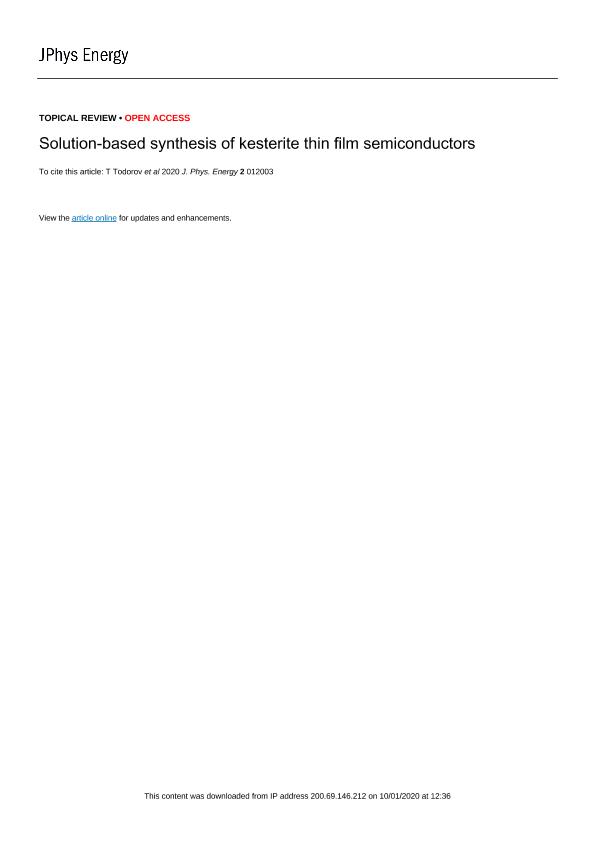Artículo
Solution-based synthesis of kesterite thin film semiconductors
Todorov, I. T.; Hillhouse, H. W.; Aazou, S.; Sekkat, Z.; Vigil Galán, O.; Deshmukh, S. D.; Agrawal, R.; Bourdais, S.; Valdes, Matias Hernan ; Arnou, P.; Mitzi, D.B.; Dale, P.
; Arnou, P.; Mitzi, D.B.; Dale, P.
 ; Arnou, P.; Mitzi, D.B.; Dale, P.
; Arnou, P.; Mitzi, D.B.; Dale, P.
Fecha de publicación:
01/2020
Editorial:
IOP Publishing
Revista:
JPhys Energy
ISSN:
2515-7655
Idioma:
Inglés
Tipo de recurso:
Artículo publicado
Clasificación temática:
Resumen
Large-scale deployment of photovoltaic modules is required to power our renewable energy future. Kesterite, Cu2ZnSn(S, Se)4, is a p-type semiconductor absorber layer with a tunable bandgap consisting of earth abundant elements, and is seen as a potential 'drop-in' replacement to Cu(In,Ga)Se2 in thin film solar cells. Currently, the record light-to-electrical power conversion efficiency (PCE) of kesterite-based devices is 12.6%, for which the absorber layer has been solution-processed. This efficiency must be increased if kesterite technology is to help power the future. Therefore two questions arise: what is the best way to synthesize the film? And how to improve the device efficiency? Here, we focus on the first question from a solution-based synthesis perspective. The main strategy is to mix all the elements together initially and coat them on a surface, followed by annealing in a reactive chalcogen atmosphere to react, grow grains and sinter the film. The main difference between the methods presented here is how easily the solvent, ligands, and anions are removed. Impurities impair the ability to achieve high performance (>∼10% PCE) in kesterite devices. Hydrazine routes offer the least impurities, but have environmental and safety concerns associated with hydrazine. Aprotic and protic based molecular inks are environmentally friendlier and less toxic, but they require the removal of organic and halogen species associated with the solvent and precursors, which is challenging but possible. Nanoparticle routes consisting of kesterite (or binary chalcogenides) particles require the removal of stabilizing ligands from their surfaces. Electrodeposited layers contain few impurities but are sometimes difficult to make compositionally uniform over large areas, and for metal deposited layers, they have to go through several solid-state reaction steps to form kesterite. Hence, each method has distinct advantages and disadvantages. We review the state-of-the art of each and provide perspective on the different strategies.
Palabras clave:
CU2ZNSN(S,SE)4
,
ELECTRODEPOSITION
,
KESTERITE
,
NANOPARTICLE
,
SOLUTION PROCESSING
Archivos asociados
Licencia
Identificadores
Colecciones
Articulos(INTEMA)
Articulos de INST.DE INV.EN CIENCIA Y TECNOL.MATERIALES (I)
Articulos de INST.DE INV.EN CIENCIA Y TECNOL.MATERIALES (I)
Citación
Todorov, I. T.; Hillhouse, H. W.; Aazou, S.; Sekkat, Z.; Vigil Galán, O.; et al.; Solution-based synthesis of kesterite thin film semiconductors; IOP Publishing; JPhys Energy; 2; 1; 1-2020; 1-22
Compartir
Altmétricas



